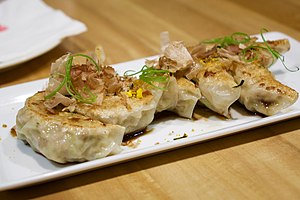Cookbook:Pork Gyoza
(Redirected from Cookbook:Gyoza)
| Pork Gyoza | |
|---|---|
 | |
| Category | Appetizer recipes |
| Servings | 5 or more |
| Time | Prep: 1 hour Cooking: 15–30 minutes |
| Difficulty | |
Cookbook | Recipes | Ingredients | Equipment | Techniques | Cookbook Disambiguation Pages | Recipes | East Asian Cuisines | Japanese Cuisine | Chinese Cuisine
Gyoza are the Japanese variation of Chinese potsticker dumplings (guotie). They consist of a thin flour dumpling skin that is filled, pleated, and pan-fried. The contrast between filling and crispy exterior is a very pleasing sensation and, like many dishes, it can be melded to incorporate almost any flavour.
Ingredients
editDumplings
edit- ½ lb ground pork
- 1–3 tsp prepared mustard
- 1–2 tbsp soy sauce
- 1–2 tbsp each of minced green onion, bell pepper, and/or chili
- At least 50 round wonton wrappers or other round dumpling skins (see note below)
Dipping Sauces
edit- Soy sauce and honey (mix to taste)
- Black bean paste
- Peanut sauce
- Plum sauce
- Black vinegar and shredded ginger
- Soy sauce with some rice wine vinegar
Procedure
editAssembly
edit- Combine the pork, mustard, soy sauce, and vegetables with clean hands.
- Get out your dumpling skins, and cover them with a damp tea-towel or paper towel to prevent them from drying out.
- Place about ½–1 tsp filling in the center of each dumpling wrapper.
- Dampen the edge of half the dumpling wrapper. Fold the wrapper in half, enclosing the filling, so the wet and dry edges meet. Crimp the edges to ensure a tight seal.
- Either proceed directly to the cooking stage, or freeze the dumplings and store frozen for up to six months.
Cooking
edit- Heat a heavy frying pan (not non-stick) over medium to medium-high heat.
- Brush the pan lightly with vegetable oil. Add 8–10 dumplings, making sure not to crowd the pan.
- Let these dumplings cook without touching them for at least 2 minutes. They will sizzle and pop, but do not touch them until they have stuck to the pan (usually about 2 minutes).
- When they have browned on the bottom (watch the edges near where the dumpling touches the pan) check for sticking.
- When the dumplings have stuck to the pan, pour about ⅓ cup of stock, broth, or water into the pan to a depth of about ⅛–¼ inch. Cover with a tight lid.
- Cook until all the liquid has been converted to steam (about 2 minutes). This is one of the more difficult parts of this process. You may have to adjust the amount of liquid used based on the liquid and your pan)
- Carefully remove the dumplings from the pan. Serve while hot with dipping sauces.
Notes, tips, and variations
edit- The primary difference between packaged gyôza skins and packaged wonton skins is shape—round for gyôza skins, square for wonton skins. Whichever one you use is a matter of preference. If both are available, try both and decide which you prefer. You can also make these skins yourself, but it is a time-consuming process and the dough has to be rolled quite thin.
- You can vary the filling ingredients to suit your taste. Pork plays well with others. Keep in mind that a filling that is too wet may expand too much during cooking and cause the dumpling to split open, while a filling that is too dry will become drier during cooking. Any filling should easily maintain its shape if moulded into smaller balls.